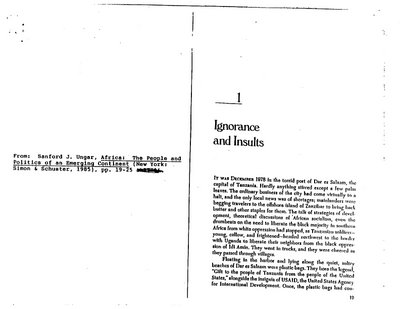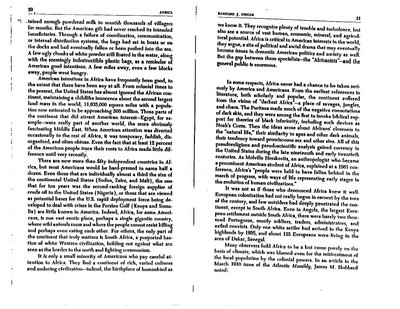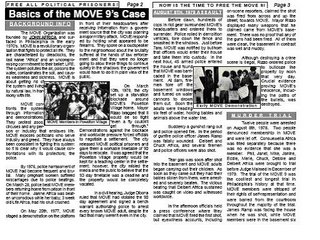Sunday, September 17, 2006
Minutes from 9/11/06
Hi All,
Here is an attempt to briefly outline the initial pathway Dr. Harris
shared with us on Monday... (scroll down) feel free to add on if you
wish.
It is my understanding that this week we are going to start asking the
young men of B Unit about their perceptions of Africa. We are also
going to bring in some "props" to debunk a few myths... Tony was
considering showing a clip of Tarzan (Saturday). Akua talked about an
article she has she might want to share (Friday).
Any other ideas?
Kalisa = Friday point person (kmm93@cornell.edu)
Tony = Saturday point person (tam34@cornell.edu)
ALSO.... if you have NOT received orientation at Mac, please plan to
stay for a few minutes after Monday's meeting so we can go over the
days/times available. Everyone MUST go through orientation at the
facility in order to volunteer at Mac. If you have already completed
orientation, this DOES NOT apply to you. I will have copies of the
paperwork you will need to complete.
leslie
----------------------
the rough outline......
I. Ancient African History
Nile Valley
Egypt - Nubia connections + cross-influence
Egypt traditionally taught as a part of European civilization
West Africa - Ghana, Mali (Mansa Musa), Songhai
Southern Africa
Catalan Atlas (published in Europe in 1235)
II. Africa/African civilization pre/post European contact
Africa source of Europe's gold
early Christian churches in Ethiopia
spread of African civilization in to Spain + Portugal
III. "Age of Enlightenment" in Europe vis-a-vis emergence of racial
classifications
justification for trade in African captives
IV. Trans-Atlantic Slave Trade
attempts to enslave indigenous populations
attempts to use indentured servants
change in laws to reflect social status maternally, instead of
paternally
impact of slavery throughout the African Diaspora
Here is an attempt to briefly outline the initial pathway Dr. Harris
shared with us on Monday... (scroll down) feel free to add on if you
wish.
It is my understanding that this week we are going to start asking the
young men of B Unit about their perceptions of Africa. We are also
going to bring in some "props" to debunk a few myths... Tony was
considering showing a clip of Tarzan (Saturday). Akua talked about an
article she has she might want to share (Friday).
Any other ideas?
Kalisa = Friday point person (kmm93@cornell.edu)
Tony = Saturday point person (tam34@cornell.edu)
ALSO.... if you have NOT received orientation at Mac, please plan to
stay for a few minutes after Monday's meeting so we can go over the
days/times available. Everyone MUST go through orientation at the
facility in order to volunteer at Mac. If you have already completed
orientation, this DOES NOT apply to you. I will have copies of the
paperwork you will need to complete.
leslie
----------------------
the rough outline......
I. Ancient African History
Nile Valley
Egypt - Nubia connections + cross-influence
Egypt traditionally taught as a part of European civilization
West Africa - Ghana, Mali (Mansa Musa), Songhai
Southern Africa
Catalan Atlas (published in Europe in 1235)
II. Africa/African civilization pre/post European contact
Africa source of Europe's gold
early Christian churches in Ethiopia
spread of African civilization in to Spain + Portugal
III. "Age of Enlightenment" in Europe vis-a-vis emergence of racial
classifications
justification for trade in African captives
IV. Trans-Atlantic Slave Trade
attempts to enslave indigenous populations
attempts to use indentured servants
change in laws to reflect social status maternally, instead of
paternally
impact of slavery throughout the African Diaspora
A Sweatshop Behind Bars
A Sweatshop Behind Bars
By Chris Levister, New America Media
Posted on September 13, 2006, Printed on September 14, 2006
http://www.alternet.org/story/41481/
If you think prison inmates only make license plates, you're
behind the times.
As a child Ayana Cole dreamed of becoming a world class
fashion designer. Today she is among hundreds of inmates
crowded in an Oregon prison factory cranking out designer
jeans. For her labor she is paid 45 cents an hour. At a chic
Beverly Hills boutique some of the beaded creations carry a
$350 price tag. In fact the jeans labeled "Prison Blues" --
proved so popular last year that prison factories couldn't
keep up with demand.
At a San Diego private-run prison factory Donovan Thomas earns
21 cents an hour manufacturing office equipment used in some
of LA's plushest office towers. In Chino Gary's prison sewn T-
shirts are a fashion hit.
Hundreds of prison generated products end up attached to
trendy and nationally known labels like No Fear, Lee Jeans,
Trinidad Tees, and other well known U.S. companies. After
deductions, many prisoners like Cole and Thomas earn about $60
for an entire month of nine-hour days. In short, hiring out
prisoners has become big business. And it's booming.
At CMT Blues housed at the Maximum Security Richard J. Donovan
State Correctional Facility outside San Diego, the highly
prized jobs pay minimum wage. Less than half goes into the
inmates' pockets. The rest is siphoned off to reimburse the
state for the cost of their incarceration and to a victim
restitution fund.
The California Department of Corrections and CMT Blues owner
Pierre Sleiman say they are providing inmates with job skills,
a work ethic and income. In addition, he says prisoners offer
the ultimate in a flexible and dependable work force. "If I
lay them off for a week," said Sleiman, referring to his
workers, "I don't have to worry about someone else coming and
saying, 'Come work for me.' "
For the tycoons who have invested in the prison industry, it
has been like finding a pot of gold. They don't have to worry
about strikes or paying unemployment, health or worker's comp
insurance, vacation or comp time. All of their workers are
full time, and never arrive late or are absent because of
family problems; moreover, if prisoners refuse to work, they
are moved to disciplinary housing and lose canteen privileges.
Most importantly, they lose "good time" credit that reduces
their sentence.
Today, there are over 2 million people incarcerated in the
U.S., more than any other industrialized country. They are
disproportionately African-American and Latino. The nation's
prison industry now employees nearly three quarters of a
million people, more than any Fortune 500 corporation, other
than General Motors. Mushrooming construction has turned the
industry into the main employer in scores of depressed cities
and towns. A host of firms are profiting from private prisons,
prison labor and services like transportation, farming and
manufacturing.
Critics argue that inmate labor is both a potential human
rights abuse and a threat to workers outside prison walls
claiming, inmates have no bargaining power, are easily
exploited and once released are frequently barred from gainful
employment because of a felony conviction.
In one California lawsuit, for example, two prisoners have
sued both their employer and the prison, saying they were put
in solitary confinement after refusing to labor in unsafe
working conditions. In a nutshell John Fleckner of Operation
Prison Reform labels the growing trend "capitalist punishment
-- slavery re-envisioned."
The prison industry is not a new phenomenon, writes Fleckner.
He says mixing the profit motive with punishment only invites
abuse reminiscent of one of the ugliest chapters in U.S.
history. "Under a regime where more bodies equal more profits
prisons take one big step closer to their historical ancestor,
the slave pen."
In fact, prison labor has its roots in slavery. Following
reconstruction, former Confederate Democrats instituted
"convict leasing." Black inmates, mostly freed slaves
convicted of petty theft, were rented out to do everything
from picking cotton to building railroads. In Mississippi, a
huge farm, resembling a slave plantation replaced convict
leasing. The infamous Parchman Farm was not closed until 1972,
when inmates brought suit against the abusive conditions in
federal court.
Prison analysts say contract prison labor is poised to become
one of America's most important growth industries. Many of
these prisoners are serving time for non-violent crimes. With
the use of tough-on-crime mandatory sentencing laws, the
prison population is bursting at the seams. Some experts
believe that the number of people locked up in the U.S. could
double in the next 10 years. According to Prison Watch, the
expansion of the number of prisoners will not only increase
the pool of prison labor available for commercial profit, but
also will help pay the costs of incarceration.
"The main goal of prison work programs is to provide "a
positive outlet to help inmates productively use their time
and energies. Another goal is to instill good work habits,
including appropriate job behavior and time management,
according to the Joint Venture Program of the California
Department of Corrections. The program is responsible for
contracting out convict labor to governments, businesses and
non-profit organizations.
Federal law prohibits domestic commerce in prison-made goods
unless inmates are paid "prevailing wages" but because the law
doesn't apply to exports, prison officials routinely market to
foreign customers.
In California the prisons themselves are their own best
customers. The California Department of Corrections purchases
about half of what the prisons make, choosing from an online
Prison Industry Authority catalog.
Prisoners now manufacture everything from blue jeans, to auto
parts, to electronics and furniture. Honda has paid inmates $2
an hour for doing the same work an auto worker would get paid
$20 to $30 an hour to do. Konica has used prisoners to repair
copiers for less than 50 cents an hour. Toys 'R' Us once used
prisoners to restock shelves, and Microsoft to pack and ship
software. Clothing made in California and Oregon prisons
competes so successfully with apparel made in Latin America
and Asia that it is exported to other countries.
In most states prisoners receive little of the money they earn
working either for state-run or private sector corrections
firms such as the Corrections Corporations of America (CCA)
and Wackenhut. The labor prisoners perform is often
considerably cheaper than in the outside world. Case in point,
Texas-based Lockhart Technologies closed its Austin plant and
fired some 150 workers who constructed circuit boards because
it could relocate those jobs to a Wackenhut-run prison where
detainees did the work for minimum wage.
But even with the low pay and potential for abuse, the labor
programs are popular with prisoners, says California Prison
Watch, which monitors the state's prisons. "Prisoner idle time
is less, they earn spending money, and they can pick up a
skill."
Tony Matos, 45 convicted of robbing a Rialto liquor store
says, "When we step through the gates and into the shop, it's
another world. This is a company. This isn't prison. Guards
still keep watch, the capitalists still profit -- the critics
and supporters still debate. But in the end, I get a skill, a
few coins and a ray of hope and dignity."
(c) 2006 Independent Media Institute.
By Chris Levister, New America Media
Posted on September 13, 2006, Printed on September 14, 2006
http://www.alternet.org/story/41481/
If you think prison inmates only make license plates, you're
behind the times.
As a child Ayana Cole dreamed of becoming a world class
fashion designer. Today she is among hundreds of inmates
crowded in an Oregon prison factory cranking out designer
jeans. For her labor she is paid 45 cents an hour. At a chic
Beverly Hills boutique some of the beaded creations carry a
$350 price tag. In fact the jeans labeled "Prison Blues" --
proved so popular last year that prison factories couldn't
keep up with demand.
At a San Diego private-run prison factory Donovan Thomas earns
21 cents an hour manufacturing office equipment used in some
of LA's plushest office towers. In Chino Gary's prison sewn T-
shirts are a fashion hit.
Hundreds of prison generated products end up attached to
trendy and nationally known labels like No Fear, Lee Jeans,
Trinidad Tees, and other well known U.S. companies. After
deductions, many prisoners like Cole and Thomas earn about $60
for an entire month of nine-hour days. In short, hiring out
prisoners has become big business. And it's booming.
At CMT Blues housed at the Maximum Security Richard J. Donovan
State Correctional Facility outside San Diego, the highly
prized jobs pay minimum wage. Less than half goes into the
inmates' pockets. The rest is siphoned off to reimburse the
state for the cost of their incarceration and to a victim
restitution fund.
The California Department of Corrections and CMT Blues owner
Pierre Sleiman say they are providing inmates with job skills,
a work ethic and income. In addition, he says prisoners offer
the ultimate in a flexible and dependable work force. "If I
lay them off for a week," said Sleiman, referring to his
workers, "I don't have to worry about someone else coming and
saying, 'Come work for me.' "
For the tycoons who have invested in the prison industry, it
has been like finding a pot of gold. They don't have to worry
about strikes or paying unemployment, health or worker's comp
insurance, vacation or comp time. All of their workers are
full time, and never arrive late or are absent because of
family problems; moreover, if prisoners refuse to work, they
are moved to disciplinary housing and lose canteen privileges.
Most importantly, they lose "good time" credit that reduces
their sentence.
Today, there are over 2 million people incarcerated in the
U.S., more than any other industrialized country. They are
disproportionately African-American and Latino. The nation's
prison industry now employees nearly three quarters of a
million people, more than any Fortune 500 corporation, other
than General Motors. Mushrooming construction has turned the
industry into the main employer in scores of depressed cities
and towns. A host of firms are profiting from private prisons,
prison labor and services like transportation, farming and
manufacturing.
Critics argue that inmate labor is both a potential human
rights abuse and a threat to workers outside prison walls
claiming, inmates have no bargaining power, are easily
exploited and once released are frequently barred from gainful
employment because of a felony conviction.
In one California lawsuit, for example, two prisoners have
sued both their employer and the prison, saying they were put
in solitary confinement after refusing to labor in unsafe
working conditions. In a nutshell John Fleckner of Operation
Prison Reform labels the growing trend "capitalist punishment
-- slavery re-envisioned."
The prison industry is not a new phenomenon, writes Fleckner.
He says mixing the profit motive with punishment only invites
abuse reminiscent of one of the ugliest chapters in U.S.
history. "Under a regime where more bodies equal more profits
prisons take one big step closer to their historical ancestor,
the slave pen."
In fact, prison labor has its roots in slavery. Following
reconstruction, former Confederate Democrats instituted
"convict leasing." Black inmates, mostly freed slaves
convicted of petty theft, were rented out to do everything
from picking cotton to building railroads. In Mississippi, a
huge farm, resembling a slave plantation replaced convict
leasing. The infamous Parchman Farm was not closed until 1972,
when inmates brought suit against the abusive conditions in
federal court.
Prison analysts say contract prison labor is poised to become
one of America's most important growth industries. Many of
these prisoners are serving time for non-violent crimes. With
the use of tough-on-crime mandatory sentencing laws, the
prison population is bursting at the seams. Some experts
believe that the number of people locked up in the U.S. could
double in the next 10 years. According to Prison Watch, the
expansion of the number of prisoners will not only increase
the pool of prison labor available for commercial profit, but
also will help pay the costs of incarceration.
"The main goal of prison work programs is to provide "a
positive outlet to help inmates productively use their time
and energies. Another goal is to instill good work habits,
including appropriate job behavior and time management,
according to the Joint Venture Program of the California
Department of Corrections. The program is responsible for
contracting out convict labor to governments, businesses and
non-profit organizations.
Federal law prohibits domestic commerce in prison-made goods
unless inmates are paid "prevailing wages" but because the law
doesn't apply to exports, prison officials routinely market to
foreign customers.
In California the prisons themselves are their own best
customers. The California Department of Corrections purchases
about half of what the prisons make, choosing from an online
Prison Industry Authority catalog.
Prisoners now manufacture everything from blue jeans, to auto
parts, to electronics and furniture. Honda has paid inmates $2
an hour for doing the same work an auto worker would get paid
$20 to $30 an hour to do. Konica has used prisoners to repair
copiers for less than 50 cents an hour. Toys 'R' Us once used
prisoners to restock shelves, and Microsoft to pack and ship
software. Clothing made in California and Oregon prisons
competes so successfully with apparel made in Latin America
and Asia that it is exported to other countries.
In most states prisoners receive little of the money they earn
working either for state-run or private sector corrections
firms such as the Corrections Corporations of America (CCA)
and Wackenhut. The labor prisoners perform is often
considerably cheaper than in the outside world. Case in point,
Texas-based Lockhart Technologies closed its Austin plant and
fired some 150 workers who constructed circuit boards because
it could relocate those jobs to a Wackenhut-run prison where
detainees did the work for minimum wage.
But even with the low pay and potential for abuse, the labor
programs are popular with prisoners, says California Prison
Watch, which monitors the state's prisons. "Prisoner idle time
is less, they earn spending money, and they can pick up a
skill."
Tony Matos, 45 convicted of robbing a Rialto liquor store
says, "When we step through the gates and into the shop, it's
another world. This is a company. This isn't prison. Guards
still keep watch, the capitalists still profit -- the critics
and supporters still debate. But in the end, I get a skill, a
few coins and a ray of hope and dignity."
(c) 2006 Independent Media Institute.






